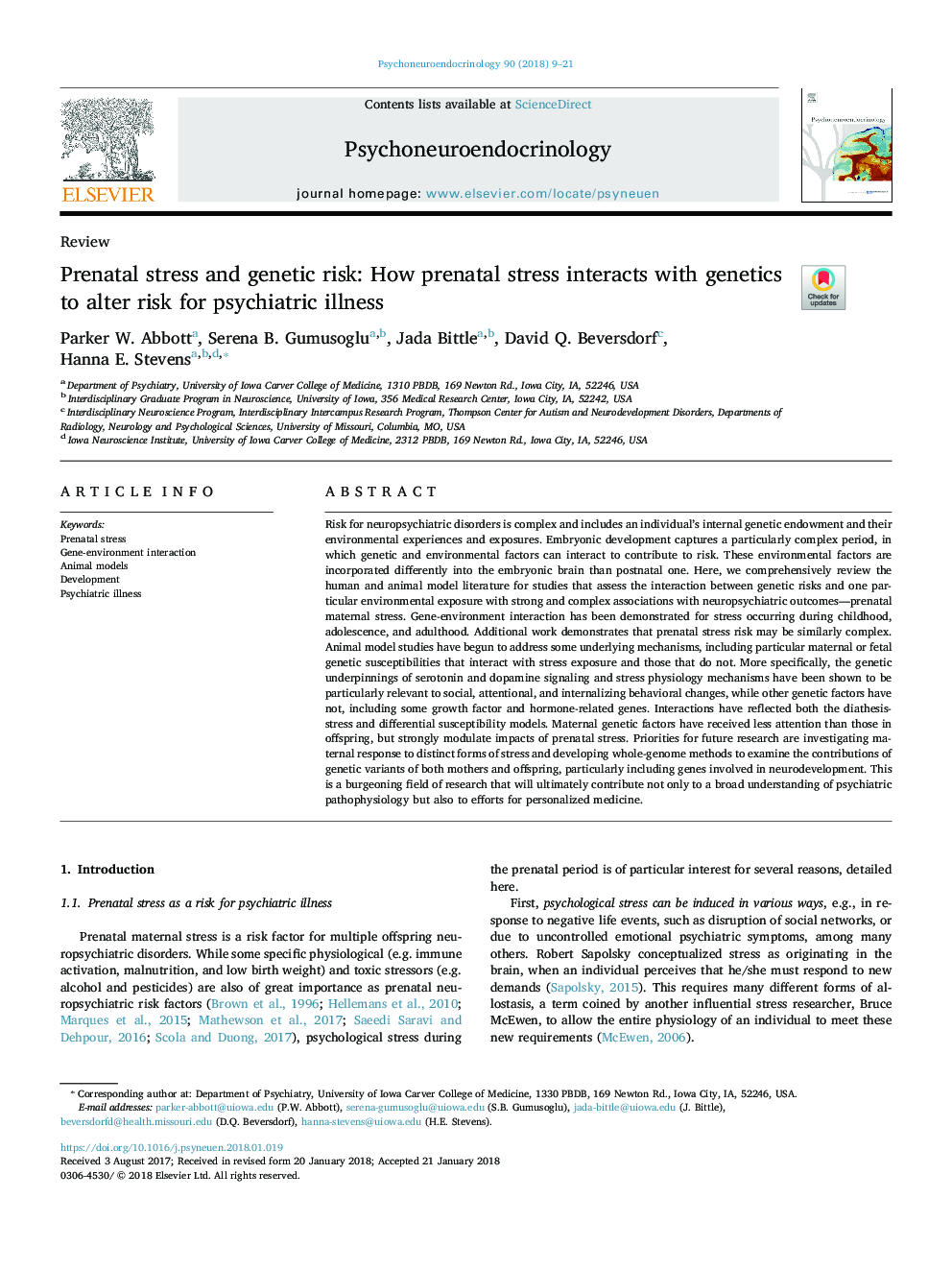| کد مقاله | کد نشریه | سال انتشار | مقاله انگلیسی | نسخه تمام متن |
|---|---|---|---|---|
| 6817699 | 1433953 | 2018 | 13 صفحه PDF | دانلود رایگان |
عنوان انگلیسی مقاله ISI
Prenatal stress and genetic risk: How prenatal stress interacts with genetics to alter risk for psychiatric illness
ترجمه فارسی عنوان
استرس پس از زایمان و خطر ژنتیکی: چگونه استرس قبل از تولد با ژنتیک تعامل می کند تا خطر بیماری روانی را تغییر دهد
دانلود مقاله + سفارش ترجمه
دانلود مقاله ISI انگلیسی
رایگان برای ایرانیان
کلمات کلیدی
استرس پس از زایمان، تعامل ژن و محیط زیست، مدل های حیوانی، توسعه، بیماری روانپزشکی،
ترجمه چکیده
خطر برای اختلالات روانپزشکی پیچیده است و شامل درآمد ژنتیکی داخلی و تجربیات و اثرات محیطی آن است. رشد جنین در دوران بسیار پیچیده ای رخ می دهد که در آن عوامل ژنتیکی و محیطی می توانند در ایجاد ریسک نقش داشته باشند. این عوامل محیطی به مغز جنینی متفاوت از پس از تولد می پردازند. در اینجا، ما به طور کامل بررسی ادبیات مدل انسان و حیوان برای مطالعاتی که تعامل بین خطرات ژنتیکی و یک قرار گرفتن در معرض محیط زیست خاص را با ارتباطات قوی و پیچیده با نتایج ناخودآگاهی و استرس مادر قبل از تولد بررسی می کند. تعامل ژن و محیط زیست برای استرس هایی که در دوران کودکی، نوجوانی و بزرگسالی رخ می دهد، نشان داده شده است. کار اضافی نشان می دهد که خطر استرس پس از زایمان ممکن است به طور مشابه پیچیده باشد. مطالعات مدل حیوانی شروع به رفع برخی از سازوکارهای زمینه ای، از جمله حساسیت های ژنتیکی مادر یا جنین که با قرار گرفتن در معرض استرس و کسانی که آن را نداشته اند، شروع شده است. به طور خاص، پایه ژنتیکی مکانیسم های فیزیولوژی سیگنالینگ و مکانیسم های فیزیولوژیک نشانه های سروتونین و دوپامین به ویژه در ارتباط با تغییرات رفتاری اجتماعی، توجه و درونی است، در حالی که دیگر عوامل ژنتیکی، از جمله برخی از عوامل رشد و ژن های مرتبط با هورمون هستند. تعاملات هر دو مدل دیاتیز-استرس و حساس بودن افتراقی را نشان می دهد. عوامل ژنتیکی مادر توجه کمتری نسبت به فرزندانشان دارند، اما تاثیرات استرس پس از زایمان را به شدت تعدیل می کنند. اولویت های تحقیق در آینده، بررسی پاسخ مادران به فرم های متمایز تنش و ایجاد روش های کل ژنوم برای بررسی مشارکت انواع ژنتیک مادران و فرزندان، به ویژه از جمله ژن هایی است که در توسعه ی عصبی نقش دارند. این یک زمینه رو به رشد از تحقیقات است که در نهایت نه تنها به درک وسیع پاتوفیزیولوژی روانپزشکی بلکه همچنین تلاش برای پزشکی شخصی تبدیل خواهد شد.
موضوعات مرتبط
علوم زیستی و بیوفناوری
بیوشیمی، ژنتیک و زیست شناسی مولکولی
علوم غدد
چکیده انگلیسی
Risk for neuropsychiatric disorders is complex and includes an individual's internal genetic endowment and their environmental experiences and exposures. Embryonic development captures a particularly complex period, in which genetic and environmental factors can interact to contribute to risk. These environmental factors are incorporated differently into the embryonic brain than postnatal one. Here, we comprehensively review the human and animal model literature for studies that assess the interaction between genetic risks and one particular environmental exposure with strong and complex associations with neuropsychiatric outcomes-prenatal maternal stress. Gene-environment interaction has been demonstrated for stress occurring during childhood, adolescence, and adulthood. Additional work demonstrates that prenatal stress risk may be similarly complex. Animal model studies have begun to address some underlying mechanisms, including particular maternal or fetal genetic susceptibilities that interact with stress exposure and those that do not. More specifically, the genetic underpinnings of serotonin and dopamine signaling and stress physiology mechanisms have been shown to be particularly relevant to social, attentional, and internalizing behavioral changes, while other genetic factors have not, including some growth factor and hormone-related genes. Interactions have reflected both the diathesis-stress and differential susceptibility models. Maternal genetic factors have received less attention than those in offspring, but strongly modulate impacts of prenatal stress. Priorities for future research are investigating maternal response to distinct forms of stress and developing whole-genome methods to examine the contributions of genetic variants of both mothers and offspring, particularly including genes involved in neurodevelopment. This is a burgeoning field of research that will ultimately contribute not only to a broad understanding of psychiatric pathophysiology but also to efforts for personalized medicine.
ناشر
Database: Elsevier - ScienceDirect (ساینس دایرکت)
Journal: Psychoneuroendocrinology - Volume 90, April 2018, Pages 9-21
Journal: Psychoneuroendocrinology - Volume 90, April 2018, Pages 9-21
نویسندگان
Parker W. Abbott, Serena B. Gumusoglu, Jada Bittle, David Q. Beversdorf, Hanna E. Stevens,
